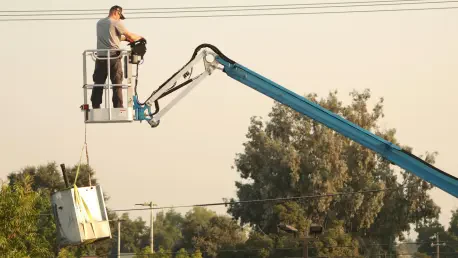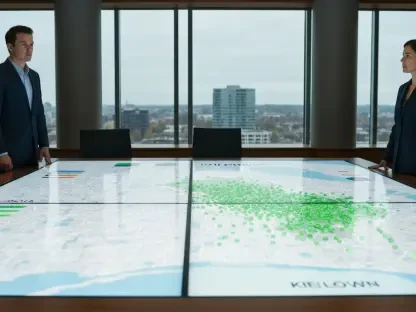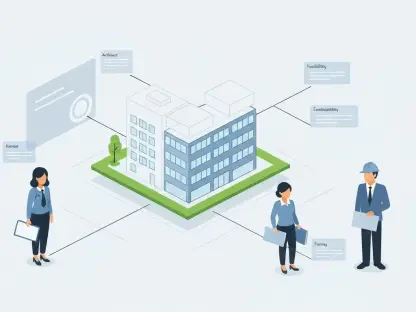In today’s fast-paced construction industry, maintaining safety while boosting productivity remains a pressing challenge. Innovative solutions are vital as companies strive to balance these demands. Among these innovations, remote tower crane control technology emerges as a notable advancement, significantly impacting the sector by promoting operational safety and efficiency. This review delves into how such technology revolutionizes crane operation, examining its features, performance, and broader implications.
Examining Technology Behind Remote Crane Control
Remote tower crane control rests on core principles focused on safety and efficiency. The technology functions with components that include video systems, control panels, and advanced communication networks. Operators can manage crane operations seamlessly from secure locations, minimizing risks associated with traditional on-site control environments. As the industry seeks to bolster safety standards, this technology plays an integral role in achieving these objectives.
Beyond safety, remote tower crane control represents a leap forward within construction technology. It aligns seamlessly with the growing trend of integrating digital solutions into construction operations, heightening productivity and precision. As part of wider safety improvements within construction methodologies, it supports sustainability by reducing the need for physical presence, thus propelling technology-driven safety measures.
Core Functionalities: Transforming Crane Operations
Remote Control Efficiency Enhancements
One of the most transformative elements of remote crane technology is its remote control functionality, which offers a novel operational framework. By eliminating the necessity for on-site presence, crane operation efficiency increases as operators can manage multiple projects with ease. Furthermore, enhanced safety measures are realized—operators can control cranes from distant locations, mitigating potential risks inherent in physically commanding cranes on-site.
This setup facilitates nearly instantaneous response to changes or challenges during construction, optimizing both time and resource management. Remote control setups reduce lag time by enabling a swift adaptation to project requirements, underscoring heightened efficiency within the construction sector.
Automation and Precision in Real-World Applications
The integration of automation within remote crane operations introduces a new facet of precision. Cutting-edge algorithms and programming ensure cranes can carry out functions with remarkable accuracy, essential for complex urban construction projects. This precision translates into tangible benefits such as reduced human error, increased safety, and minimized costly operational setbacks.
Real-world applications exemplify these advantages, with remote tower cranes operating in constrained urban settings where precision is crucial. This advanced technology ensures minimal disruption to surrounding areas while maintaining high standards of safety and effectiveness.
Recent Innovations Redefining Crane Control
The landscape of remote tower crane control is characterized by continuous technological advancements and novel industry practices. New features include enhanced remote user interfaces, increased machine learning applications for predictive maintenance, and refined communication systems, ensuring seamless interaction between various project components.
Emerging innovations such as virtual reality (VR) training modules allow operators to engage in immersive learning environments, honing skills without risk. These improvements highlight a commitment to evolving the technology further, ensuring these systems remain on the cutting edge of construction technology.
Implementation and Ubiquity Across Construction Sectors
The construction industry witnesses a growing embrace of remote tower crane control technology, with varied applications evident across numerous sectors. Its deployment ranges from large-scale urban developments to infrastructure projects—each benefiting from its inherent efficiency and safety enhancements.
Standout implementations include skyscraper developments in bustling urban centers, where traditional crane operation would present significant logistical challenges. By leveraging remote control, operators can deftly navigate the unique demands of these environments, showcasing the technology’s adaptability across the industry.
Encountering Challenges and Overcoming Barriers
Despite its advantages, remote tower crane control technology encounters several hurdles. Technical concerns such as system failures or connectivity issues pose risks to seamless operations. Regulatory questions about safety standards and operator training must be addressed to standardize practices and ensure widespread acceptance.
Efforts to overcome these barriers include rigorous testing protocols and comprehensive training programs for operators. Market education campaigns aim to emphasize the technology’s benefits, fostering a climate receptive to embracing such advancements within the industry.
Prospects and Transformative Potential
Looking forward, remote tower crane control technology is poised to expand its impact. Anticipated advancements may include integration with other emerging technologies, such as artificial intelligence, for predictive analytics in operational decision-making. These improvements promise to revolutionize construction, enhancing precision, cutting costs, and elevating safety.
Long-term potential lies in the technology’s ability to recalibrate entire construction paradigms, influencing everything from project planning to execution. As it becomes more embedded in construction frameworks, its influence is set to reinforce not only industry standards but also societal perspectives on sustainable and safe building practices.
Reflections on Remote Crane Control
Having explored the strategic integration of remote tower crane control technology within the construction industry, it became apparent that such systems offer undeniable benefits. Their ability to shift focus toward more efficient, safer, and smarter construction practices marked a significant milestone in construction technology. The technology’s advancement within complex environments and its potential to impact future construction practices depicted a positive trend toward innovative operation methodologies. As it continues to evolve, remote crane control technology stands on the verge of transforming the broader landscape of construction, setting new records for excellence and safety in the industry.









